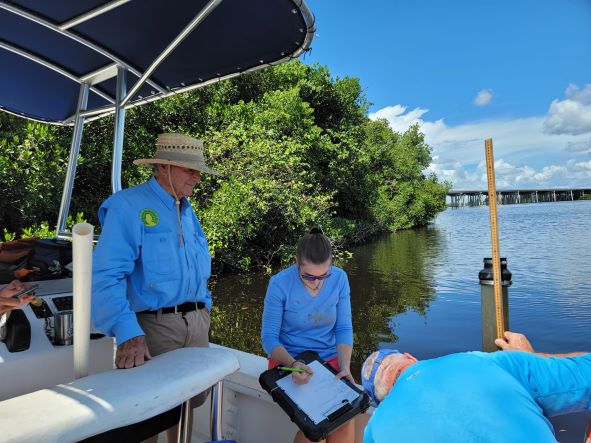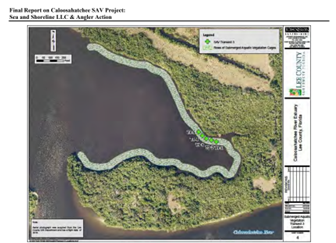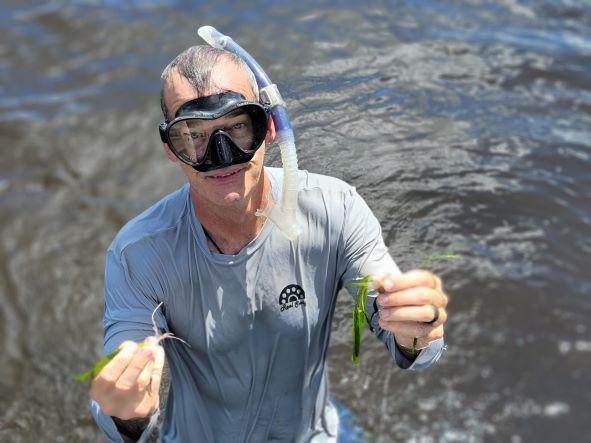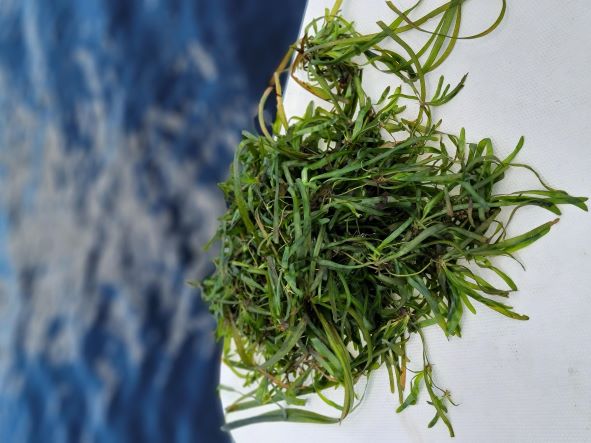
Project Update: Angler Action’s Caloosahatchee River SAV Restoration on Track
In 2017, the Angler Action Foundation (AAF) started the process of restoring submerged aquatic vegitation (SAV) in the Caloosahatche River. Site selection criteria for the project was partially based on historical growth and current lack thereof – meaning that we picked areas where there used to be a lot of grass and now there is none. (Another critical aspect of site selection was understanding WHY the grass left. This is worth a full article, but for now just know that the ‘why’ is equally important as ‘where’.)
Funding was secured from Florida’s Department of Environmental Protection (FDEP), and two companies were hired to complete the work: Sea & Shoreline for the planting and maintenance of the SAVs, and Johnson Engineering for a handful of 3rd party monitoring aspects.
The initial project called for the planting of 20 acres, and three areas in the river were chosen to get started. Planting material consisted mostly of vallisneria, a genus of fresh water long bladed grass referred to as tape grass among other names, and Ruppia maritima which can tolerate swings in salinity.
 The planting process included plants in larger biodegradable pots planted by hand then placed under cages which protected them from herbivory (which means getting chowed down by critters), and many smaller plant units planted both mechanically and by hand canvassing the areas within the 20-acre sites. After extensive planning and a thorough permitting process, planting began in 2019.
The planting process included plants in larger biodegradable pots planted by hand then placed under cages which protected them from herbivory (which means getting chowed down by critters), and many smaller plant units planted both mechanically and by hand canvassing the areas within the 20-acre sites. After extensive planning and a thorough permitting process, planting began in 2019.
The most recent site visit by AAF and Johnson Engineering revealed extremely promising results. All three sites have had cages removed (save a small handful of control cages) so we were all anxious to see just how the planted grass was faring. Further, additional funding has been secured to expand the project, with a couple acres planted and caged at a new site. We had a lot to see.
Site visits included areas #1 and #3 of Phase 1, and the lone site for phase 2. (Site area #2 was not included as I had very recently visited that site with Sea & Shoreline and knew that the grass was growing well there.)
First stop was at area #3 (pictured above, image courtesy Johnson Engineering), which is very close to Owl Creek. Here, we planted SAV all around the perimeter of the small cove. The center of the cove was deemed to deep and murky/mucky to initially support grass, so we stuck to the rim.
 The AAF team was represented by myself and board member Pete Quasius, and Johnson Engineering had a few biologists on hand who were completing core samples and general visual inspections of the sites with us. Included in that crew was David Ceilley, who has been an important intellectual resource throughout the project.
The AAF team was represented by myself and board member Pete Quasius, and Johnson Engineering had a few biologists on hand who were completing core samples and general visual inspections of the sites with us. Included in that crew was David Ceilley, who has been an important intellectual resource throughout the project.
Our visit did not disappoint – a swim around the cove revealed a carpet of grass that covered just about the entire rim. In fact, I didn’t find any areas that didn’t have grass as long as I stayed within about 25-30 feet from the mangrove covered shoreline.
The grass is highly grazed. Most of the blades were around 3 inches long. But there was way more of it than we initially planted, which is a great sign. Initial surveys in the area didn’t find a single blade of Vallisneria. Now, the perimeter is covered. Full plants were even showing up in the core samples taken by Johnson Engineering.
The visibility of the water in the area is very low, so the grass is not visible from the surface. And the fact that it is still being grazed so heavily indicates that the restoration in the region is far from complete – these plants need to flower and seed if they are going to perform optimally – but the team was exuberant with the progress. Pete, who was an Orvis endorsed fly fishing guide in the area with his wife Maria, was thrilled. “Back in the day, this entire stretch of the river was teeming with life. After the grass left, there has been nothing. The grass here has exceeded my hopes, I am very pleased with these results,” he said as we left the site for Site #1.
 Site #1 is visible looking west from the I75 bridge, with plants along the northern shore of an island. Here the grass is performing even better – the water clarity is slightly better, the bottom more cohesive and less mucky, and the grass again blankets the area. The difference here is that the blades are up to a foot long throughout the area. As we approached, we saw evidence of a manatee feeding in the area – a muddy path and some grass blades and roots floating on the surface – a very, very good sign. Further, for the first time since the project started, when I swam along the bottom with a snorkel and mask, I saw dozens and dozens of small fish darting here and there in front of me. Again, this area had NO grass before we planted, and now it is thriving with life.
Site #1 is visible looking west from the I75 bridge, with plants along the northern shore of an island. Here the grass is performing even better – the water clarity is slightly better, the bottom more cohesive and less mucky, and the grass again blankets the area. The difference here is that the blades are up to a foot long throughout the area. As we approached, we saw evidence of a manatee feeding in the area – a muddy path and some grass blades and roots floating on the surface – a very, very good sign. Further, for the first time since the project started, when I swam along the bottom with a snorkel and mask, I saw dozens and dozens of small fish darting here and there in front of me. Again, this area had NO grass before we planted, and now it is thriving with life.
Across the river at the Phase 2 location, gass inside the new cages was thriving, growing up to 24-inch blades and throwing ‘floaters’ by the basketful into the water. There was even signs of some grass creeping out from the cages, indicating that the area is a strong candidate for further expansion.
Is the work done? Far from it. Up to 2000 acres of grass have been lost. Manatees, turtles, ducks, fish, crabs and other critters devour the grass. A ‘tipping point’ needs to be met so that the natural process of grazing can help expand the area, not chew what is there down to a nub. Vallisneria can expand by sending rhizomes underground, but this process is slow, inconsistent and localized. It just won't be able to keep up with the herbivory, seasonal growth variances, and other factors that can slow the growth and expansion. To fully complete the SAV restoration in the area, enough needs to be planted so grazing does not bring the meadows below flowering and seeding capabilities.
As AAF moves forward with the project, we are more confident than ever that by planting in strategic locations that allow for optimal growth and eventual natural seed transport, we can achieve grass meadows that are self-sustaining and expand on their own.
If you have questions about this project, or are interested in working with AAF to accomplish similar work in your area, please contact Brett Fitzgerald (brett@angleraction.org).
